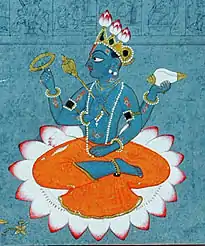A shaktyavesha avatara (Sanskrit: शक्त्यावेशावतार, romanized: Śaktyāveśāvatāra) is the power-embodied avatara (incarnation) of a deity in the Vaishnava tradition of Hinduism.[1] The concept refers to living beings who are empowered by a deity towards the performance of certain acts or the achievement of a given mission. A portion of the potencies of a deity is believed to be present (āveśā) within a shaktyavesha avatara, invested with divine power. Vyasa, the Four Kumaras, Narada, Shesha, and Brahma are generally regarded to be the shaktyavesha avatars of Vishnu or Krishna in Vaishnavism.[2]
Literature
| Part of a series on |
| Vaishnavism |
|---|
 |
Garga Samhita
The Garga Samhita states that a shaktyavesha avatara is one of the six forms of incarnation of the deity Krishna, identified with Vishnu. The purpose of such an incarnation is regarded to be to enter a jiva (living being) in order to perform a given mission, after which the deity departs from this form.
Chaitanya Charitamrita
The Chaitanya Charitamrita offers six categories of the shaktyavesha avatars of Krishna and their purposes:[3]
- Shesha, empowered for the personal service of Vishnu (sva-sevana-śakti) and bearing all the planets within the universe (bhū-dhāraṇa-śakti)
- Brahma, empowered for the creation of the cosmos (sṛṣṭi-śakti)
- The Four Kumaras, empowered to distribute transcendental knowledge (jñāna-śakti)
- Narada, empowered to distribute devotional service (bhakti-śakti)
- Prithu, empowered to rule and maintain living entities (pālana-śakti)
- Parashurama, empowered to cut down rogues and demons (duṣṭa-damana-śakti)
See also
References
- ↑ Caṭṭopādhyāẏa, Rāmapada; Chattopadhyay, Ramampada (1992). A Vaiṣṇava Interpretation of the Brahmasūtras: Vedānta and Theism. BRILL. pp. 211–212. ISBN 978-90-04-09570-0.
- ↑ Knapp, Stephen (2005). The Heart of Hinduism: The Eastern Path to Freedom, Empowerment, and Illumination. iUniverse. p. 513. ISBN 978-0-595-35075-9.
- ↑ Sri Caitanya Caritamrita | "Sri Caitanya Caritamrta Madhya-lila Chapter 20 Verse 246". Archived from the original on 2008-12-09. Retrieved 2008-12-20.
